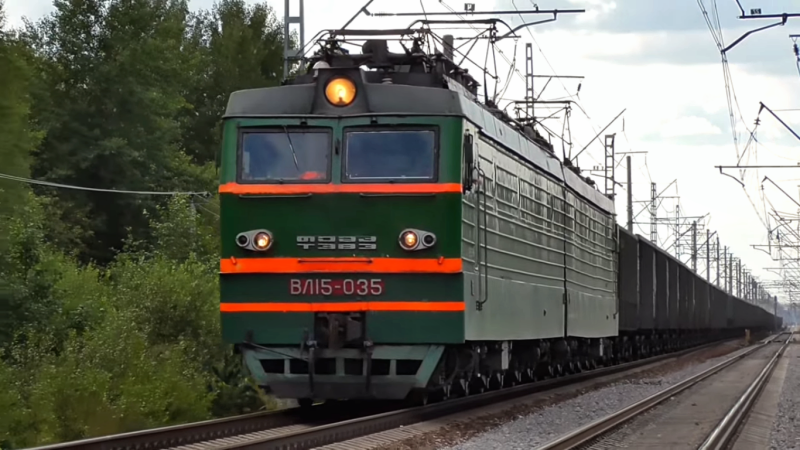At first, the idea was to castelt on a similar version - the eight-axle VL14, which had received a sufficient degree of modernization. But increased volumes of domestic traffic prompted the creation of something more powerful.
 Powerful Soviet electric locomotive VL15 with a long load. Photo: youtube.com
Powerful Soviet electric locomotive VL15 with a long load. Photo: youtube.comAs a solution, it was proposed to assemble a twelve-axle locomotive, capable of simultaneously transporting a much larger number of freight cars. An alternative option was VL85 on alternating current. The question became especially relevant after a drive with a support-frame installation of traction motors showed a number of problems in operation (models VL81 and VL84).
Powerful technology for DC areas
If the “eighty-fifth” model met the needs of roads with alternating current, then it was necessary to solve the situation using alternative power. It is for this reason that designers tried to create a similar technique intended for use in areas with constant traction.
The primary task was to create a two-section locomotive with six axles on each of them. It was designed with a view to future production at facilities in the Georgian capital. Since the end of 1984, TEVZ began assembling an electric locomotive, which received the name VL15.
Even before the physical appearance of the technology, it was created in the form of drawings on the basis of the special design bureau “Electrovozostroitel”. At the same time, the mechanics lay entirely with the engineers from Novocherkassk. After all, the unification with VL85 turned out to be very high. In addition to a rather limited number of details related to other operating conditions:
✅ body parts
✅ other type of electrical equipment
✅ auxiliary components
This move ultimately led to the fact that the new product was unified in terms of electronics with the “eleventh”, and in terms of mechanics - with the “eighty-fifth” models. About nine months after its creation, the first VL15 prototype went for testing at the Sverdlovsk-Sortirovochny station.
In general, the creators came to the conclusion that the most appropriate use for the most powerful DC locomotive is the East Siberian Railway. And it’s not surprising, because local cargo transportation at that time was growing at a fairly respectable pace.
 In the driver's cabin of the VL15 electric locomotive. Photo: youtube.com
In the driver's cabin of the VL15 electric locomotive. Photo: youtube.comTherefore, already from the fourth sample VL15 they received registration in those parts. Practice has fully confirmed the primary findings. And in the early 90s, other examples of locomotives that had previously operated in Sverdlovsk went to Siberia.
Technical indicators and features of the electric locomotive
At a time when testing of the first model was in full swing (at the end of 1985), Georgian specialists released the second locomotive. They tried to improve the characteristics of regenerative braking. For this purpose, NB-436V converters were used in traction electric motors. In general, each section of the electric locomotive received a number of identical elements borrowed from its predecessors:
✅ auxiliary circuit switch BVE-2
✅ a pair of T-5M1 pantographs
✅ switch for power traction motors BVP-5A
The locomotive had 12 electric motors (six in each section). They received either a serial or series-parallel connection. The first was used when using equipment in shunting mode or turning off a faulty motor. Regardless of the type of active connection, it is possible to enable regenerative braking. This is what VL15 drives have:
✅ six main poles
✅ the same number of additional ones
✅ compensation winding on them
To control them, the equipment was equipped with a driver controller. This element is installed on the KME-001 model. Working on it consisted of using several handles with different purposes. This includes all driving and stopping modes:
✅ main handle
✅ reverse-selective
✅ brake drive
All electrical equipment is rated at 3000 VDC. The insulating winding of motors should also be included in this number. By the way, the latter could be models TL-3A or TL-3B. The drive mass was about five tons, and the armature rotation speed was 1690 rpm. Each section of the locomotive is equipped with one 40NK-125 battery.
 Instruments of the electric locomotive VL15. Photo: youtube.com
Instruments of the electric locomotive VL15. Photo: youtube.comGiven the increased power and the use of twelve electric motors at once, manufacturers did not provide the equipment with the ability to work using the System of Many Units (SME). This was also hampered by the maximum permissible operating conditions for energy supply devices.
Work on CME and change of geography of use
Despite this, over time the situation has undergone dramatic changes. By 1988, it became technically possible to use paired structures. A similar decision was prompted by the situation on the East Siberian Railway, where large trains required maximum power from the locomotives used.
In the same year, the first unit of equipment appeared, designated VL15S-024. Trains of this series had the ability to use sections of up to four units at the same time. The direction was clearly recognized as promising, having decided to build only “C” type electric locomotives in the future. As a result, only four units were born from the planned huge batch.
 Hall with power equipment of the VL15 electric locomotive. Photo: youtube.com
Hall with power equipment of the VL15 electric locomotive. Photo: youtube.comAfter many sections of roads on Lake Baikal began to be converted to variable traction, the VL15, which had lost their scope of application, were sent to the Kandalaksha depot of the Oktyabrskaya road. Later samples from No. 0037 to 0044 were also relocated there. The transfer to another type of power supply continued. After Murmansk became “variable”, the VL15 electric locomotives moved to work at the Volkhovstroy depot.
We have already spoken more than once about the high power characteristics of two-section locomotives. Perhaps it's time to present them in real numbers. Let us immediately note that they are truly impressive. Here are some of them:
✅ maximum speed - 100 km / h
✅ structure weight – 300 t
✅ total power of 12 electric motors – 9 mW
Several factors prevented the wider spread of VL15. Among which the most important are: the gradual transition of many sections of roads to variable traction and the collapse of the USSR in 1992. The latter (including the period preceding it) led to a significant decrease in all types of transportation throughout the country. In such conditions, super-powerful locomotives completely lost their relevance.
 Electric locomotive VL15 in conjunction with electric locomotive VL10 according to CME. Photo: youtube.com
Electric locomotive VL15 in conjunction with electric locomotive VL10 according to CME. Photo: youtube.comTherefore, the total circulation of the mainline equipment was limited to a modest 50 copies. Despite this, it still received several design modifications. This number includes VL15A, in which regenerative braking was abandoned, and the already mentioned VL15S. Sometimes VL15M, released in 1992 in the amount of 2 copies, is also put in the same row with them. But some experts are still inclined to classify it as a prototype of the new E13.










